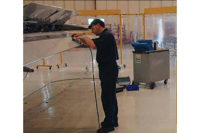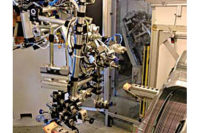While designing the A350 XWB (extra wide body) airplane in early 2010, Airbus’ engineers proposed a revolutionary way to build the plane’s wings at the company’s plant in Broughton, UK. Specifically, they wanted the wings built horizontally rather than the traditional vertical method.
When a wing is built vertically, its leading edge is often pointed to the roof, and its orientation is changed with an overhead crane. Horizontal build, in contrast, involves using automatic guided vehicles (AGVs) to move the wing to different workstations on the assembly floor. There is no need to ever rotate the wing during assembly.
To implement a horizontal build process, Airbus turned to Electroimpact, which had designed and built the wing-manufacturing systems for Airbus’ A320, A330 and A340 commercial planes, as well as its A400M military transport aircraft. The company also did work on the Airbus A380, the world’s largest commercial passenger aircraft.
Electroimpact’s system to assemble A350 wings consisted of several workstations, where a jig holds the wing skeleton in place while the top and lower skin panels are applied through a series of drilling, bolting and tacking operations. Automated machines perform all rib-to-spar assembly operations. Some workers oversee these machines, while others perform select manual operations.
Damon Griffiths, project support manager at Electroimpact, says there are three main challenges when designing a horizontal-build system. First and foremost, the 33-meter-long wings must be high enough off the ground so workers can easily access the wing from above or below, and drilling, bolting and tacking machines easily pass underneath.
A second challenge is allowing enough room around the wing to account for its curvature and ensure easy worker access with minimum physical strain. The system also needs to be expandable to accommodate production increases over time.
To meet these challenges, Electroimpact had Bosch Rexroth custom develop two types of aluminum-profile platforms for the system. Inboard (near the center) platforms, measuring 14 meters long and 6 meters wide, are positioned at the widest part of the wing. Lower-access platforms feature hinged flip flooring that links together like a jigsaw puzzle.
A total of four inboard and 36 lower-access platforms are used to provide workers complete access across the length and width of each wing. The platforms are maneuvered into place with AGVs. Both types feature drop-down guarding, point-of-use services (such as air and electricity), floor lighting, access steps, handrails for fencing between production cells, and flag carts for component storage.
“The platforms [provide] access [to] all areas of the wing with minimal additional equipment, and give Airbus the chance to construct the new wing in a safe manner,” notes Griffiths. “Their modular design [also] offers more flexibility during manufacture and for ongoing modifications than a heavy, fixed welded structure.”
Airbus paid more than $1 million for the platforms, but Griffiths says they continue to be a cost-effective investment for the company. For more information on modular, structural aluminum profiles and components, call 800-739-7684 or visit www.boschrexroth-us.com.





